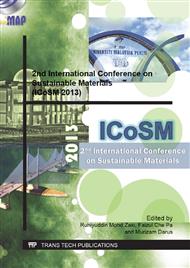[1]
J. Luyten, S. Mullens, J. Cooymans, A. M. De Wilde, I. Thijs, R. Kemps, Different methods to synthesize ceramic foams, J. Eur. Ceram. Soc. 29 (2009) 829-832.
DOI: 10.1016/j.jeurceramsoc.2008.07.039
Google Scholar
[2]
J. Luyten, S. Mullens, J. Cooymans, A. M. De Wilde, I. Thijs, New processing techniques of ceramic foams, J. Adv. Eng. Mater. 5 (2003) 715-718.
DOI: 10.1002/adem.200300381
Google Scholar
[3]
S. Sharafat, N. Ghoniem, M. Sawan, A. Ying, B. Williams, Breeder foam : An innovative solid breeder material for fusion application, J. Am. Ceram. Soc. 81 (2006) 455-460.
DOI: 10.1016/j.fusengdes.2005.06.374
Google Scholar
[4]
S. Dhara, P. Bhagarva, A simple direct casting route to ceramic foams, J. Am. Ceram. Soc. 86 (2003) 1645-1650.
DOI: 10.1111/j.1151-2916.2003.tb03534.x
Google Scholar
[5]
V. D. Goula, Blachou, C. Philippopoulos, Wet milling of alumina and preparation of slurries for monolithic structures impregnation, Ind. Eng. Chem. Res. 31 (1992) 364-369.
DOI: 10.1021/ie00001a049
Google Scholar
[6]
Y. S, Han, J. B. Li, Y. J. Chen, Q. M. Wei, A study on the factors involved in collapse of macroporous α-Al2O3 structure, J. Mater. Proc. Tech. 128 (2002) 313-317.
Google Scholar
[7]
H. X. Peng, Z. Fan, J. R. G. Evans, J. J. C. Busfield, Microstructure of ceramic foams, J. Eur. Ceram. Soc. 20 (2000) 807-813.
DOI: 10.1016/s0955-2219(99)00229-0
Google Scholar
[8]
S. Woyansky, J. Scott, C. E., Processing of ceramic foams, Am. Ceram. Soc. Bull. 71 (1999) 1674-1682.
Google Scholar
[9]
X. Zhu, D. Jiang, S. Tan, The control of slurry rheology in the processing of reticulated ceramic foams, Mater. Res. Bull. 37 (2002) 541-553.
Google Scholar
[10]
P. Colombo, J. R. Hellmann, Ceramic foams from preceramic polymers, Mat. Res. Inn. 6 (2002) 260-272.
Google Scholar
[11]
M. R. Nangrejo, X. Bao, M. J. Edirisinghe, Preparation of silicon carbide-silicon nitride composite foams from preceramic polymers, J. Eur. Ceram. Soc. 20 (2000) 1777-1785.
DOI: 10.1016/s0955-2219(00)00046-7
Google Scholar
[12]
R. Riedel, Advanced ceramics from inorganic polymers, in: R. J. Brook (Ed.), Materials science and technology, a comprehensive treatment, Processing of ceramics, Part II, Wiley-VCH, Weinheim, 1995, pp.1-50.
Google Scholar
[13]
P. Colombo, E. Bernardo, Macro and micro-cellular porous ceramics from preceramic polymers, J. Comp. Sci. Tech. 63 (2003) 2353-2359.
DOI: 10.1016/s0266-3538(03)00268-9
Google Scholar
[14]
J. E. Martini-Vvedensky, N. P. Suh, F. A. Waldman, Microcellular closed cell foams and their method of manufacture, U. S. Patent 4, 473, 665. (1984)
Google Scholar
[15]
J. D. LeMay, R. W. Hopper, L. W. Hrubesh, R. W. Pekala, Low-density microcellular materials, Mat. Res. Bull. 15 (1990) 19-45.
DOI: 10.1557/s0883769400058103
Google Scholar
[16]
L. Montanaro, Y. Jorand, G. Fantozzi, A. Negro, Ceramic foams by powder processing, J. Eur. Ceram. Soc. 18 (1998) 1339-1350.
DOI: 10.1016/s0955-2219(98)00063-6
Google Scholar
[17]
J. D. Li, Y. L. Shi, Y. Q. Cai, S. F. Mou, G. B. Jiang, Adsorption of di-ethyl-phthalate from aqueous solutions with surfactant-coated nano/ microsized alumina, J. Chem. Eng. 140 (2008) 214-220.
DOI: 10.1016/j.cej.2007.09.037
Google Scholar
[18]
H. Schmidt, D. Koch, G. Grathwohl, P. Colombo, Micro and macroporous ceramics from preceramic precursors, J. Am. Ceram. Soc. 84 (2001) 2252-2255.
DOI: 10.1111/j.1151-2916.2001.tb00997.x
Google Scholar
[19]
O. Lyckfildt, J. M. F. Ferreira, Processing of porous ceramics by starch consolidation, J. Eur. Ceram. Soc. 18 (1998) 131-140.
Google Scholar
[20]
W. P. Minnear, Processing of foamed ceramics, in: M. J. Cima (Ed.), Ceramic transactions, forming science and technology for ceramics, Am. Ceram. Soc., Westerville, OH, 1992, pp.149-156.
Google Scholar
[21]
P. Sepulveda, Gelcasting of foams for porous ceramics, J. Am. Ceram. Soc. 76 (1997) 61-65.
Google Scholar
[22]
Z. Zivcova, E. Gregorova, W. Pabst, S. David, A. Michot, C. Poulier, Thermal conductivity of porous alumina ceramics prepared using starch as a pore-forming agent, J. Eur. Ceram. Soc. 29 (2009) 347-353.
DOI: 10.1016/j.jeurceramsoc.2008.06.018
Google Scholar
[23]
P. Sepulveda, J. G. P. Binner, Processing of cellular ceramics by foaming and in situ polymerisation of organic monomers, J. Eur. Ceram. Soc. 19 (1999) 2059-2066.
DOI: 10.1016/s0955-2219(99)00024-2
Google Scholar
[24]
F. S. Ortega, F. A. O. Valenzuela, C. H. Scuracchio, V. C. Pandolfelli, Alternative gelling agents for the gelcasting of ceramic foams, J. Eur. Ceram. Soc. 23 (2003) 75-80.
DOI: 10.1016/s0955-2219(02)00075-4
Google Scholar
[25]
U. T. Gonzenbach, A. R. Studart, E. Tervoort, L. J. Gauckler, J. Am. Ceram. Soc. 90 (2007) 16.
Google Scholar
[26]
F. Zhang, T. Kato, M. Fuji, M. Takahashi, J. Eur. Ceram. Soc. 26 (2006) 667.
Google Scholar
[27]
M. Xiaojian, W. Shiwei, S. Shunzo, Porous ceramics with tri-modal pores prepared by foaming and starch consolidation, J. Ceram. Int. 34 (2008) 107-112.
DOI: 10.1016/j.ceramint.2006.08.009
Google Scholar


